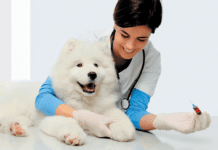You See a Beautiful Polished Floor. Your Dog Sees an Ice Skating Rink.
Sure, you may love the look of a gleaming hardwood or tile floor, but perhaps your dog equates stepping onto such a surface with the way one might see a treacherous foray onto the ice in slippery shoes.
On the Horizon: Dog Cancer Screening Via a Urine Sample
The molecules in a dog’s urine have a unique fingerprint, and researchers are finding that it can be used to detect—in minutes—whether a dog has cancer. There are blood tests for canine cancer, but they can be expensive, and you have to wait for a lab to come back with the results. Moreover, the results might be only about 60 percent accurate. With a urine test, researchers are finding results that are more than 90 percent accurate.
When $35 of Prevention is Worth More than $10,000 of Cure
Inoculation against a bacterial disease called leptospirosis is not considered a core vaccine, meaning you should discuss with your vet whether your particular dog is at risk. The offending bacteria particularly thrive in relatively warm climates with high average rainfall.
Which Sunscreen, and for Which Dogs?
Sunburn can especially affect thinly-furred dogs and is sometimes also a precursor to canine skin cancer. You can put a T-shirt on your pet, but certainly during the summer hours when sunlight is at its strongest—from about 9 AM to 3 PM—sunscreen may also be necessary on parts of his body that the cloth won’t cover, like the bridge of his nose and the tips of his ears. Some dogs, like those with short hair and pink skin (think Dalmatians or Chinese cresteds), would benefit from a sprayable sunscreen applied pretty much all over their bodies, with an SPF of at least 15. There is a commercial sunscreen approved for dogs called Dermoscent Sun Free.
If You and Your Dog Are Traveling by Air
More than 2 million pets travel by air each year, according to the U.S. Department of Transportation. If your canine family member is going to be one of them, it’s good to get him acclimated ahead of time.














